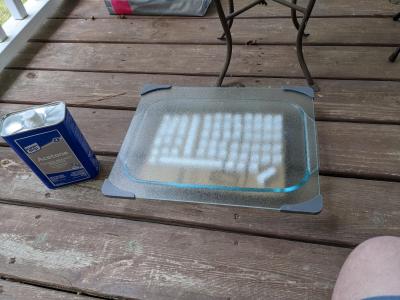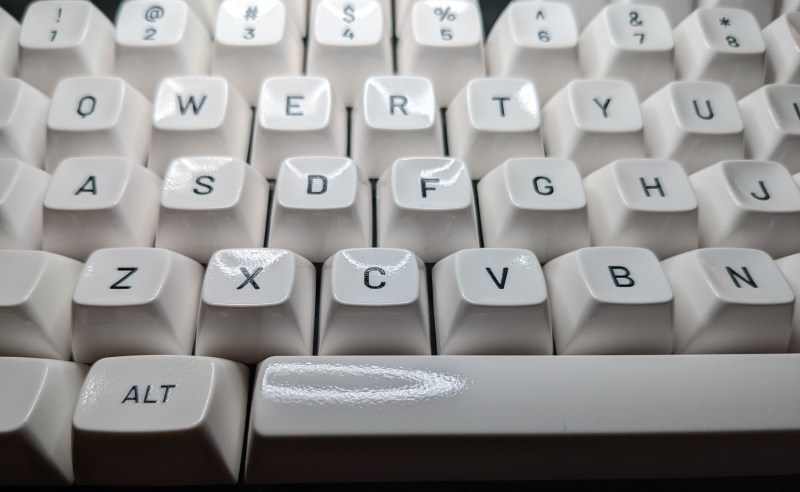No matter how often you wash your hands, ABS keycaps will eventually exhibit shine wherever you strike them the most. And that’s the problem right there: the shine might be okay if it were somehow uniform across the surface of the keycaps, but instead it just tends to make one feel seen. And since there’s really nothing you can do except to replace your keycaps (or start with PBT), you might as well embrace the shine, right?
 Well, that’s how [mmalluck] feels, anyway. He recently experimented with using acetone vapors to refinish a set of keycaps from Drop, making them super-duper shiny in the process. Now, the operative word here is
Well, that’s how [mmalluck] feels, anyway. He recently experimented with using acetone vapors to refinish a set of keycaps from Drop, making them super-duper shiny in the process. Now, the operative word here is vapors, because straight acetone would acid-wash those ‘caps faster than you can say ‘bad idea jeans’.
So to that end, [mmalluck] poured acetone in a glass cake pan, used a piece of cardboard to separate the keycaps from the acetone, and covered it all with a glass cutting board. It doesn’t take very long to achieve a good result, and [mmalluck] says it’s better to err on the side of too-short instead of risking reaching the point of too-melted.
We wouldn’t have thought we’d react this way, but we think they’re pretty cool looking. That particular set seems just right for this process, which makes them look like new old-stock typewriter keys or something. Looks way better than the ultra-personalized shine of usage. What do you think? Let us know in the comments.
Via KBD #90
















Well, if the chemistry in the oils on your skin makes ABS shiny, then the Acryonitle, butadene, and styrene are getting on your hands. All three of those chemicals either causes cancer or is strongly suspected.
It’s not chemistry. It’s physical polishing by wear.
A woman at the office that was notorious for “wearing out” key caps was also a chronic hand lotion user. I think some of it is chemistry
Only when it’s printed on or glued on. Normal keycaps (doubleshot as mentioned in a comment below) won’t have that effect.
And even without chemistry normal wear will remove printed or glued on writing over time.
Or hand lotion acts as a mild abrasive
Years of experimentation starting when I was around 13 🕐 indicate otherwise.
Given my experience with shine it’s very much related to related to how much a given key is used and in the contact pressure points I don’t think that’s chemistry. I think it’s mostly abrasion. She probably type more than anybody else.
I am quite doubtful that it’s only physical wear. Fingertips are much softer than keys. Dust could accelerate the wear, though the problem is likely mostly chemical. It’s just like acetone polishing 3D printed parts. It seems that the acids or the oils in in our skin can help break down the keys.
But fingernails aren’t. I don’t keep mine particularly long, but they’ve obliterated their share of stick-on legends and then started in on the keycap itself.
Back in the old days when I did front line IT support, I saw a number of keyboards where the key caps had been sculpted into alien shaped Salvador Dali would love. It appeared the typists’ fingernails had mechanically pushed the plastic over time into the weird contortions. I never saw the problem on IBM keyboards though, which ironically had easily replaceable outer keycap shells. The matte surface of the IBM keys does eventually get polished by repeated use though, be it chemical or mechanical.
I still use the classic buckled spring keyboards from IBM on my own PCs, rPis, etc. (with PS/2 to USB adapters) I found a vendor at the Dayton Hamvention back in then 1990s selling off a new old stock PC/AT and compact IBM keyboards and I bought a couple arm loads of them. They still get daily use and look pretty good. I had one go bad after almost 30 years of use where the controller chip just died. IBM really did their homework on the design, making the keyboards able to stand up to daily 8+ hours of word processing department use and not to cause undue fatigue.
If you can find an old PC/AT keyboard at a flea market or garage sale, grab it and try it out. You’ll be surprised at how good it is.
The average human being ingests a credit cards worth of plastic per week in America because of microplastics and food packaging. You think the amount that makes a finish polished on keycaps is going to cause cancer from getting on your skin vs ingesting all that plastic you already ingest anyway?
In addition to the other comments that it’s definitely physical polishing going on here, plastics don’t decompose to their starting chemicals, just like water doesn’t flow uphill. Any room temperature decomposition products will be much less reactive, so more likely to be biologically inert.
I have not noticed differential shine on my key caps. But I do notice that certain keys, particularly in the home position, have the letters worn off. Does not matter to me, my fingers are blind, and my eyes watch either the material I am copying (rare) or the screen where the letters appear.
What does puzzle me is why my wife insists on replacing her keyboard at home when letters wear off. She types a lot more than I do, so why does she need to see letters on the key caps?
You can avoid this problem in the future by using doubleshot keycaps instead of printed ones. These are injected with black plastic from the back to form the letters as a solid object, so they can’t wear off.
or remarry
I used to have a colleague who had really rough fingertips. On average would take him 18 months to wear holes through the most commonly used keys. Hardened keys caps might have helped, but i’m not sure they even exist.
I expect I would feel better typing when I can see the letters labeled, just as I feel better with a game controller when I can read the ABXY+- labels (I had one with recessed labels that couldn’t be read in the dark so I put white paint in the recessions and it made the controller much more pleasant), prefer watching movies with subtitles regardless of the language, and want my students to have name tags on their desks. In all cases, there is a pleasant security in having things visible and not relying entirely on memory or oral information, even if I could.
Coat new keycaps with clear fingernail polish; renew as needed.
Most of the commonly used solvents in nail polish are not going to be kind the ABS.
Looks like some 60s IBM typewriter. Though I guess a lot of that is the shape and font on the key set.
The profile was actually designed to be like the old IBM beamsprings (the ones with the solenoid for extra clacky), so not surprising!
They do a few variations now, and the fonts vary a little which can make them look more or less IBM-y.
There’s a similar profile by one of the other keycap companies that’s based on DEC’s and they’re pretty similar, though different in their own way.
It looks great TBH. it reminds me some old gear such as early desk calculators.
I’m definitely a PBT user personally…
There’s this one time when I printed custom legends on blank keycaps, and used Cerakote (the ones used for car bumper plastics that come in pads) as the finish. It’s almost as shiny as this.
What did you use to print the legends? Dye sublimation?
I “have” to make my own keycaps because I need special characters, but I can’t seem to find a simple way to do so…
That simply the effect of polishing a surface. It happens everywhere. Statues in temples or tourist locations also have this shiny effect where many people touched.
“No matter how often you wash your hands, ABS keycaps will eventually exhibit shine wherever you strike them the most.”
As others mentioned, that’s a polishing effect and is completely independent of washing your hands. Unless you touch heavy chemicals regularly.
This, and I have seen shiny steel keypads on ATM from too frequent use. Especially the 1,5,0 keys from dialling in an amount of money to withdraw are worn out.
I love smooth, shiny keycaps. Less friction the better.
Shiny is better than grungy.
At a former workplace several programmers snacked at their workstations.
It seems the oils from an orange peel are the biggest problem.
Difficult to clean.
Did you try cleaning them with some of that citrus based cleaner? You know the whole apples to apples and oranges to oranges thing? ;)
There’s nothing you can do but replace your keycaps?
I’ll disagree. My mouse developed shiny areas on the sides which affected the grip. It was a simple matter to place a sharp sewing needle in an X-acto handle and spend a few minutes very lightly jabbing the shiny surfaces in a random manner to create a stippling effect that looks close to the original. I wouldn’t hesitate to do the same with keycaps.
Even better, place a piece of 100 grit sandpaper on the spot and rub in the profile of the sand in with the blunt but hard grip of a screwdriver. The dullness returns.
What does it mean to “feel seen”? I don’t understand exactly which/what emotion you’re trying to avoid.
I like the shineyness, it reminds me of all the lines of code I’ve written. Or comments here :-)
However my latest Dell laptop just peels the painted-on tops instead. It’s like typing on a leper’s back now. Such a disappointment.